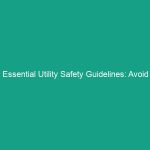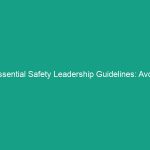Introduction
Good morning team! Today, we’re diving into an important topic that affects not just our comfort, but also our Safety on the job—Essential Temporary Heating Guidelines: Avoid These Critical Risks. As the colder months approach, many of us will rely on temporary heating solutions to keep our work Environment safe and warm. However, with these solutions come significant risks that we must address to ensure everyone’s Safety.
Understanding Essential Temporary Heating Guidelines
Temporary heating refers to the use of portable heaters or other devices to provide warmth in areas where permanent heating systems are either inadequate or non-existent. These guidelines are crucial because improper use of temporary heating can lead to serious Hazards such as fire risks, carbon monoxide poisoning, and other safety concerns.
Many employees may think that any heating solution can be used without repercussions. However, it’s essential to understand that not all heaters are created equal, and the risks associated with their misuse can have devastating consequences. By following the essential temporary heating guidelines, we can ensure a safer working environment for everyone.
Key Hazards, Risks, and Safety Considerations
When it comes to temporary heating, there are several hazards and risks to be aware of:
- Fire Risks: Many portable heaters can easily ignite nearby flammable materials if not placed properly.
- Carbon Monoxide Poisoning: Some heating devices emit carbon monoxide, which is a colorless, odorless gas that can be deadly.
- Electrical Hazards: Overloading circuits or using damaged cords can lead to electrocution or Fires.
- Burn Risks: Contact with hot surfaces can result in severe Burns, especially in high-traffic areas.
Ignoring these risks can lead to real-world consequences. For instance, a workplace fire caused by an improperly placed heater can not only damage property but also put lives in jeopardy. Let’s ensure we communicate these risks effectively and work together to mitigate them.
Best Practices, Procedures, & Actionable Advice
Here are some Best Practices to follow when using temporary heating solutions:
1. Choose the Right Heater
Not all heaters are suitable for every environment. Ensure you select a heater that is designed for indoor use and is appropriate for the size of the space.
2. Maintain Safe Distances
Keep heaters at least three feet away from flammable materials, including paper, wood, and fabric. This distance minimizes the risk of fire hazards.
3. Ensure Proper Ventilation
If using gas-powered heaters, ensure proper ventilation to prevent carbon monoxide buildup. Install carbon monoxide detectors in enclosed spaces to provide an early warning.
4. Regular Inspections
Regularly inspect heaters for any signs of damage, such as frayed cords or leaks. This ensures that the equipment is safe for use and reduces the risk of electrical hazards.
5. Follow Manufacturer Instructions
Always read and follow the manufacturer’s instructions for installation and Operation. This includes guidelines on placement, maintenance, and safety features.
6. Never Leave Heaters Unattended
Turn off heaters when leaving the area or going to sleep. This simple precaution can prevent accidents and ensure safety.
Case Study
In a previous winter, a construction site experienced a fire due to an electric heater placed too close to a stack of cardboard boxes. The fire spread rapidly, resulting in injuries and significant property damage. This incident highlights the importance of adhering to Safety Guidelines.
Regulations, Standards, and Compliance
It’s essential to comply with relevant safety Standards, such as those set by OSHA (Occupational Safety and Health Administration). These Regulations are designed to protect workers and ensure safe operating conditions. Non-compliance can lead to severe penalties and, more importantly, endanger lives.
Familiarize yourself with your company’s specific safety protocols regarding temporary heating. Understanding and following these regulations not only protects you but also your colleagues and the overall workplace environment.
Employee Engagement & Discussion
Now that we’ve discussed essential temporary heating guidelines and the associated risks, let’s engage in a discussion. Here are some questions to consider:
- What safety challenges have you encountered related to temporary heating in the past?
- Can you share any experiences where safety protocols helped prevent an incident?
- What measures do you think we can implement to improve heating safety in our workplace?
Feel free to share your thoughts and experiences. Open dialogue is crucial in reinforcing our safety culture.
Conclusion & Key Takeaways
To wrap up, remember that safety is everyone’s responsibility. By adhering to the Essential Temporary Heating Guidelines, we can significantly reduce risks and create a safer workplace for all. Here are the key takeaways:
- Choose the appropriate heating equipment.
- Maintain safe distances from flammable materials.
- Ensure proper ventilation and use carbon monoxide detectors.
- Conduct regular inspections and follow manufacturer instructions.
- Never leave heaters unattended.
Thank you for your attention and commitment to safety. Together, we can ensure that our workplace remains a safe and healthy environment for everyone.


